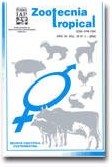
|
Zootecnia Tropical
Instituto Nacional de Investigaciones Agrícolas Venezuela
ISSN: 0798-7269
Vol. 26, No. 2, 2008, pp. 105-115
|
 Bioline Code: zt08014
Bioline Code: zt08014
Full paper language: Spanish
Document type: Research Article
Document available free of charge
|
|
|
Zootecnia Tropical, Vol. 26, No. 2, 2008, pp. 105-115
| en |
Chemical Composition, Total Polyphenols Content and Nutritional Value of Browsing Species at the Silvopastoral System in Argentinean Arid Chaco
Rossi, Carlos A.; De León, Marcelo; González, Gabriela L.; Dib, Patricia Chagra & Pereyra, Ana M.
Abstract
The objective of this study was to determine the chemical composition, total polyphenols content (TPC), and nutritional value of the main browsing species of the Argentinean arid Chaco. The results showed that crude protein (CP) registered a range between 19.4% for Mimozyganthus carinatus

and 10.2% for Aspidosperma quebracho-blanco

. For neutral detergent fiber, the values were high for Acacia aroma

(46.7%), Prosopis flexuosa

(44.3%), and A. quebracho-blanco (42.3%) and minimum for Bulnesia foliosa

(17.9%). For acid detergent fiber, Bulnesia foliosa had the maximum value with 41.2% and B. foliosa with the lowest, 13.8%. For TPC, the highest values were 24.3 and 14.4% for Larrea cuneifolia and Larrea divaricata, respectively, while the lowest values were 3.6, 3.4, and 1.2% for Bulnesia foliosa, A. quebracho-blanco, and Celtis pallida

, respectively. The in situ degradability analyses for dry matter (ISD DM) and CP (ISD CP) were carried out at 24 and 48 h. For ISD DM at 24 h, B. foliosa (86.7%), C. pallida (72.1%) and L. divaricata (67.9%) were the species with the highest values. The smallest values were for M. carinatus (44.5%), Prosopis torquata (44.2%), and Bulnesia foliosa (27.1%). For ISD DM at 48 h, the species grouped in similar form. The ISD CP analyses showed values greater than 70% in most of the species ( B. foliosa, C. pallida, L. divaricata, A. quebracho-blanco, L. cuneifolia and P. flexuosa). For both lapses, B. foliosa showed the higest values (91.7 and 91.3% for 24 and 48 h, respectively) and Bulnesia foliosa with the lowest (18.4 and 16.8% for 24 and 48 h, respectively). Positive correlations were not detected among TPC and ISD DM and ISD CP. probably due to the TPC method used is not specific for tannins.
crude protein, fiber, in situ degradability, xerophytic forest, goats, cattle.
|
| |
| es |
Composición Química, Contenido de Polifenoles Totales y Valor Nutritivo en Especies de Ramoneo del Sistema Silvopastoril del Chaco Árido Argentino
Rossi, Carlos A.; De León, Marcelo; González, Gabriela L.; Dib, Patricia Chagra & Pereyra, Ana M.
Resumen
El objetivo del trabajo fue determinar la composición química, contenido de polifenoles totales (CPT) y valor nutritivo en las principales especies de ramoneo del sistema silvopastoril del Chaco árido argentino. Los resultados mostraron para proteína bruta (PB) un rango entre 19,4% para Mimozyganthus carinatus

y 10,2% para Aspidosperma quebracho-blanco

. Para fibra detergente neutro, los valores fueron elevados: 46,7% para Acacia aroma

, 44,3% Prosopis flexuosa

, 42,3% A. quebracho-blanco y el mínimo 17,9% resultó para Bulnesia foliosa

. El porcentaje de fibra detergente ácido resultó máximo (41,3%) en Bulnesia foliosa y mínimo (13,8%).en B. foliosa. Los mayores CPT se encontraron en Larrea cuneifolia (24,3%) y Larrea divaricata (14,4%) y los menores en Bulnesia foliosa (3,6%), A. quebracho-blanco (3,4%) y Celtis pallida

1,2%). Los análisis de la degradabilidad in situ de la materia seca (DIS MS) y de la PB (DIS PB) se realizaron a lapsos de 24 y 48 h. Para DIS MS a 24 h, B. foliosa (86,7%), C. pallida (72,1%) y L. divaricata (67,9%) resultaron con la mayor degradabilidad. Los menores valores fueron para M. carinatus (44,47%), Prosopis torquata (44,2%) y Bulnesia foliosa (27,1%). Para DIS MS a 48 h, las especies se agruparon en forma similar. La DIS PB mostró valores superiores al 70% en la mayoría de las especies ( B. foliosa, C. pallida, L. divaricata, A. quebracho-blanco, L. cuneifolia y P. flexuosa) Para ambos lapsos, B. foliosa resultó con los mayores valores (91,7 y 91,3% para 24 y 48 h, respectivamente), mientras que Bulnesia foliosa mostró los menores (18,4 y 16,8% para 24 y 48 h, respectivamente). No se detectaron correlaciones positivas entre CPT y la DIS MS y de la DIS PB, probablemente debido a que la técnica usada no es especifica para detectar solo taninos.
proteína bruta, fibra, degradabilidad in situ, bosque xerofítico, caprinos, vacunos.
|
| |
© Copyright 2005 - Zootecnia Tropical
Alternative site location: http://www.sian.inia.gob.ve/repositorio/revistas_ci/ZootecniaTropical/ztindice.htm
|
|
